Implementing Data Engineering Solutions Using Microsoft Fabric Questions and Answers
HOTSPOT
You have a Fabric workspace that contains two lakehouses named Lakehouse1 and Lakehouse2. Lakehouse1 contains staging data in a Delta table named Orderlines. Lakehouse2 contains a Type 2 slowly changing dimension (SCD) dimension table named Dim_Customer.
You need to build a query that will combine data from Orderlines and Dim_Customer to create a new fact table named Fact_Orders. The new table must meet the following requirements:
Enable the analysis of customer orders based on historical attributes.
Enable the analysis of customer orders based on the current attributes.
How should you complete the statement? To answer, select the appropriate options in the answer area.
NOTE: Each correct selection is worth one point.
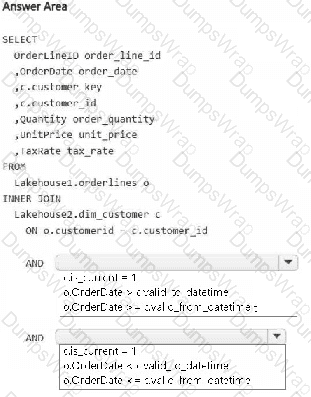
You have a Fabric workspace that contains a warehouse named DW1. DW1 is loaded by using a notebook named Notebook1.
You need to identify which version of Delta was used when Notebook1 was executed.
What should you use?
You have a Fabric workspace that contains a semantic model named Model1.
You need to dynamically execute and monitor the refresh progress of Model1.
What should you use?
You have a Fabric workspace named Workspace1 that contains a warehouse named Warehouse1.
You plan to deploy Warehouse1 to a new workspace named Workspace2.
As part of the deployment process, you need to verify whether Warehouse1 contains invalid references. The solution must minimize development effort.
What should you use?
You have a Fabric warehouse named DW1 that loads data by using a data pipeline named Pipeline1. Pipeline1 uses a Copy data activity with a dynamic SQL source. Pipeline1 is scheduled to run every 15 minutes.
You discover that Pipeline1 keeps failing.
You need to identify which SQL query was executed when the pipeline failed.
What should you do?
You have a Fabric workspace named Workspace1 that contains a warehouse named DW1 and a data pipeline named Pipeline1.
You plan to add a user named User3 to Workspace1.
You need to ensure that User3 can perform the following actions:
View all the items in Workspace1.
Update the tables in DW1.
The solution must follow the principle of least privilege.
You already assigned the appropriate object-level permissions to DW1.
Which workspace role should you assign to User3?
You have a table in a Fabric lakehouse that contains the following data.
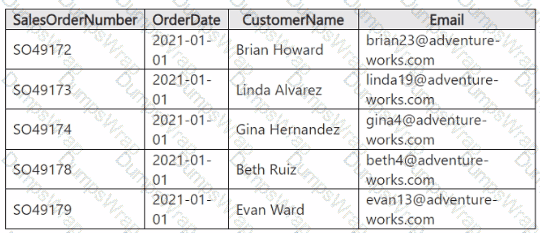
You have a notebook that contains the following code segment.

For each of the following statements, select Yes if the statement is true. Otherwise, select No.
NOTE: Each correct selection is worth one point.

You have an Azure key vault named KeyVaultl that contains secrets.
You have a Fabric workspace named Workspace-!. Workspace! contains a notebook named Notebookl that performs the following tasks:
• Loads stage data to the target tables in a lakehouse
• Triggers the refresh of a semantic model
You plan to add functionality to Notebookl that will use the Fabric API to monitor the semantic model refreshes. You need to retrieve the registered application ID and secret from KeyVaultl to generate the authentication token.
Solution: You use the following code segment:
Use notebookutils.credentials.getSecret and specify the key vault URL and key vault secret. Does this meet the goal?
You have a Fabric capacity that contains a workspace named Workspace1. Workspace1 contains a lakehouse named Lakehouse1, a data pipeline, a notebook, and several Microsoft Power BI reports.
A user named User1 wants to use SQL to analyze the data in Lakehouse1.
You need to configure access for User1. The solution must meet the following requirements:
Provide User1 with read access to the table data in Lakehouse1.
Prevent User1 from using Apache Spark to query the underlying files in Lakehouse1.
Prevent User1 from accessing other items in Workspace1.
What should you do?
You have a Fabric notebook named Notebook1 that has been executing successfully for the last week.
During the last run, Notebook1executed nine jobs.
You need to view the jobs in a timeline chart.
What should you use?
You have a Fabric workspace named Workspace1.
You plan to configure Git integration for Workspace1 by using an Azure DevOps Git repository. An Azure DevOps admin creates the required artifacts to support the integration of Workspace1 Which details do you require to perform the integration?
You need to populate the MAR1 data in the bronze layer.
Which two types of activities should you include in the pipeline? Each correct answer presents part of the solution.
NOTE: Each correct selection is worth one point.
You need to recommend a method to populate the POS1 data to the lakehouse medallion layers.
What should you recommend for each layer? To answer, select the appropriate options in the answer area.
NOTE: Each correct selection is worth one point.
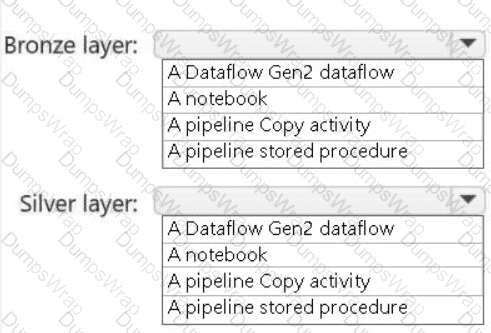
You need to recommend a solution for handling old files. The solution must meet the technical requirements. What should you include in the recommendation?
You need to ensure that the data engineers are notified if any step in populating the lakehouses fails. The solution must meet the technical requirements and minimize development effort.
What should you use? To answer, select the appropriate options in the answer area.
NOTE: Each correct selection is worth one point.

You need to create the product dimension.
How should you complete the Apache Spark SQL code? To answer, select the appropriate options in the answer area.
NOTE: Each correct selection is worth one point.
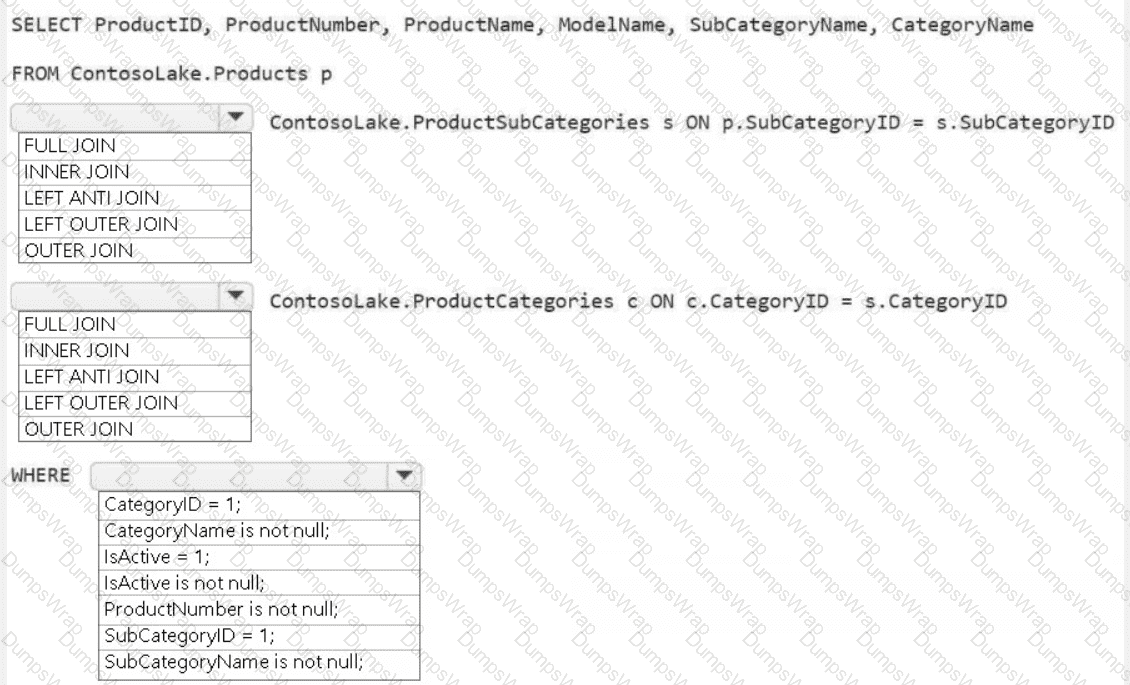
You need to ensure that the data analysts can access the gold layer lakehouse.
What should you do?
You need to schedule the population of the medallion layers to meet the technical requirements.
What should you do?
You need to ensure that usage of the data in the Amazon S3 bucket meets the technical requirements.
What should you do?
You need to recommend a solution to resolve the MAR1 connectivity issues. The solution must minimize development effort. What should you recommend?
You need to ensure that WorkspaceA can be configured for source control. Which two actions should you perform?
Each correct answer presents part of the solution. NOTE: Each correct selection is worth one point.
What should you do to optimize the query experience for the business users?




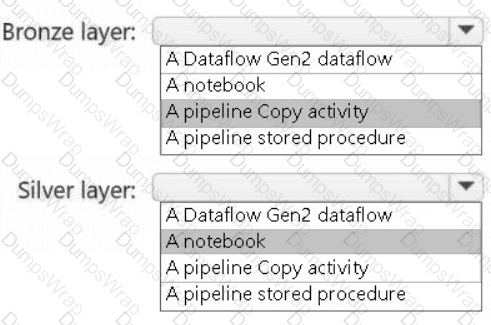 A screenshot of a computer Description automatically generated
A screenshot of a computer Description automatically generated

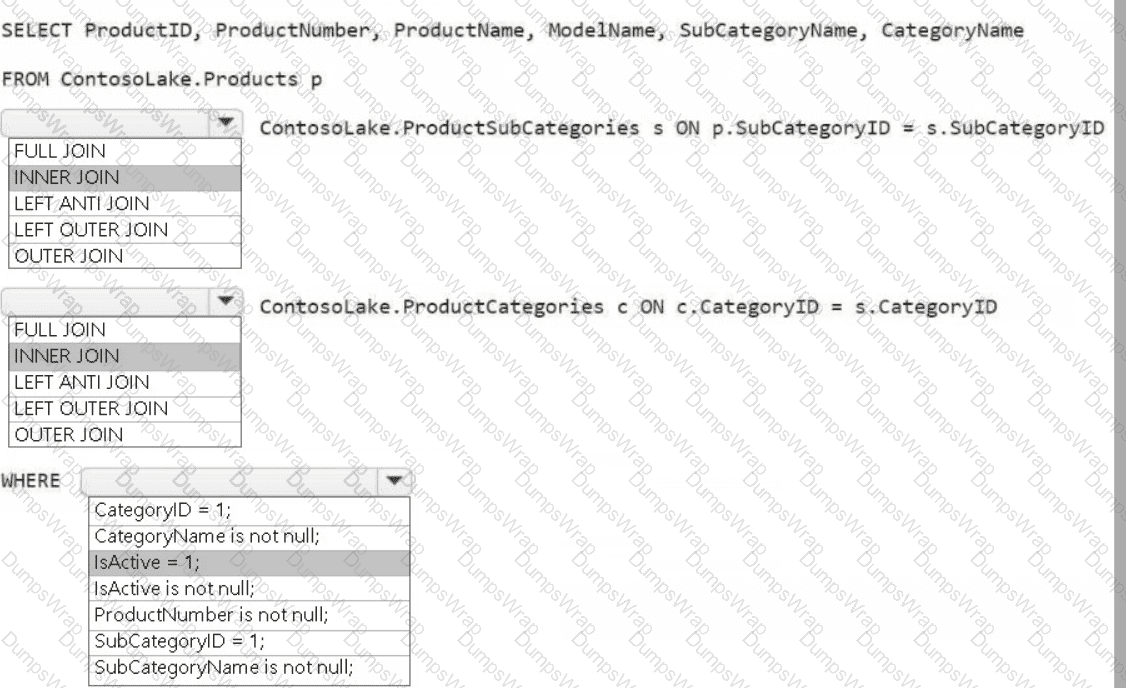 A screenshot of a computer Description automatically generated
A screenshot of a computer Description automatically generated